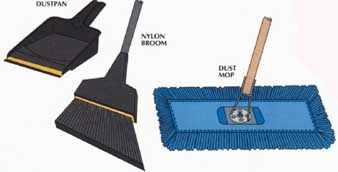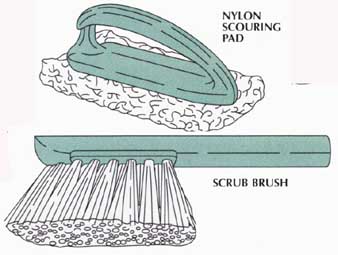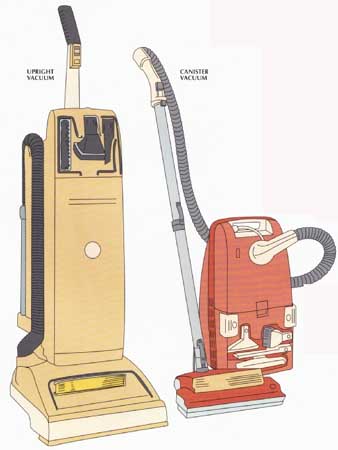An Arsenal of Cleaning Tools
| Home | Wiring | Plumbing | Kitchen/Bath |
|
A with any task, cleaning is easier when you have the proper tools. For major jobs—such as buffing floors or scouring heavily soiled masonry — you may need to rent specialized equipment; but for most tasks, a basic set of implements is all you’ll need. To obtain top-quality tools, consider a trip to a janitorial supply store. Besides these items, keep on hand a few other implements. A flexible-blade putty knife is ideal for scraping candle wax and chewing gum from hard surfaces. For mixing cleaning compounds, choose a polyethylene pail rather than a metal one, which can be damaged by acids and chlorine. The most effective dusters are made of lamb’s wool or ostrich feathers, rather than chicken feathers or synthetics. Special dusting cloths with a tacky finish or a static charge or treated paper sheets also work well. You’ll also need cloth: Plain white cotton is preferable to synthetics for cleaning because it’s absorbent; especially useful are terry-cloth toweling and cotton-knit fabrics such as old T-shirts. Sandpaper and steel wool are essential for removing stubborn stains and for polishing surfaces. Stock several grades, from 20- to 600-grit in sandpaper and from #1 to #4/0 in steel wool. The right mop for the job. The most effective mop for a given situation depends on the job. For large expanses of uncarpeted floor, a good choice is a string mop with a commercial-style wringer bucket. A sponge mop is more convenient for small kitchens and bathrooms, and does not require a wringer bucket. Basic sweeping tools. The best brooms have nylon bristles that won’t break off and scatter. Bristles cut at an angle will get into tight corners more easily than the square-cut type. Select a dustpan with a rubber lip to keep dirt from being swept underneath. A ridge along the edge prevents debris from spilling out. Pans with long handles save you the trouble of bending down. A dust mop with a swiveling head is even more effective than a broom for picking up dust.
Scrubbing implements. For general scouring, choose a nylon pad. These are often attached to a small handle, the back of a sponge, or a long extension handle. With many brands, the color of the pad indicates its level of abrasiveness: a black or brown pad is highly abrasive, white nonabrasive, and blue and green medium. Scrub most surfaces with the nonabrasive white pad. For irregular surfaces, a scrub brush works better than a pad. Nylon bristles are more durable than natural bristles and dry more quickly. But natural bristles are required with acid, which will cause nylon to deteriorate. The length and diameter of the bristles determine their stiffness or softness. Scrub brushes are available in a number of sizes; some have threaded sockets for attaching long handles. Toothbrushes and shoe-polish applicators are ideal for get ting into crannies such as those in wickerwork. Two types of vacuum cleaner. Vacuums come in two varieties: upright and canister. Uprights with brushes on a rotating shaft called a beater bar are best suited for deep-cleaning carpets. With more suction than most uprights and with special hose attachments, canister vacuums excel at cleaning upholstery and uncarpeted floors, get ting into crevices, and reaching areas above floor level. Hybrids—uprights with hose attachments and canister vacuums with a beater-bar nozzle—are also available. For convenience, buy an upright vacuum for carpets and a small canister for other jobs. For vacuuming drapes and other lightweight objects, a suction-reducing feature is handy. If you have large surfaces to clean, you may want an upright model that moves forward automatically. Other convenient features are a retractable cord and an easy- to-change bag. NYLON SCOURING PAD SCRUB BRUSH UPRIGHT VACUUM CANISTER VACUUM
|
| HOME | Prev: A Battery of Cleaning Products | Next: | Article Index |

 //11
//11 
 //12
//12